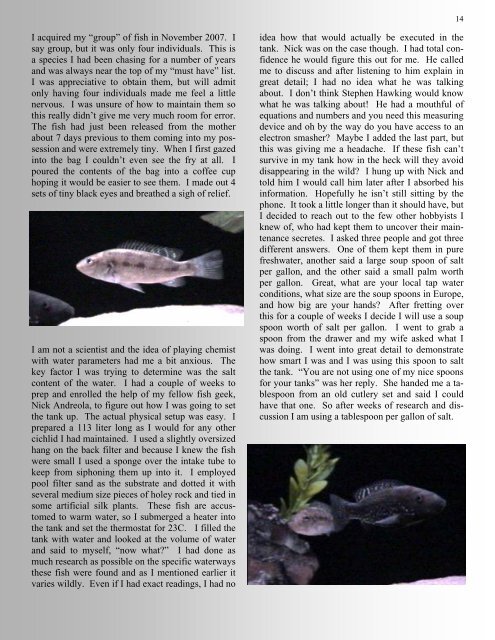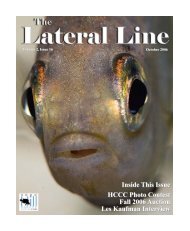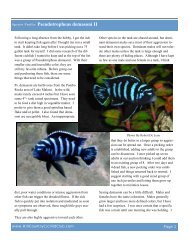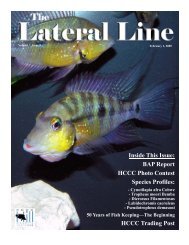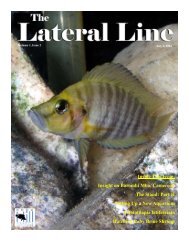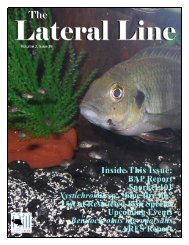December - Hill Country Cichlid Club
December - Hill Country Cichlid Club
December - Hill Country Cichlid Club
Create successful ePaper yourself
Turn your PDF publications into a flip-book with our unique Google optimized e-Paper software.
14<br />
I acquired my “group” of fish in November 2007. I<br />
say group, but it was only four individuals. This is<br />
a species I had been chasing for a number of years<br />
and was always near the top of my “must have” list.<br />
I was appreciative to obtain them, but will admit<br />
only having four individuals made me feel a little<br />
nervous. I was unsure of how to maintain them so<br />
this really didn’t give me very much room for error.<br />
The fish had just been released from the mother<br />
about 7 days previous to them coming into my possession<br />
and were extremely tiny. When I first gazed<br />
into the bag I couldn’t even see the fry at all. I<br />
poured the contents of the bag into a coffee cup<br />
hoping it would be easier to see them. I made out 4<br />
sets of tiny black eyes and breathed a sigh of relief.<br />
I am not a scientist and the idea of playing chemist<br />
with water parameters had me a bit anxious. The<br />
key factor I was trying to determine was the salt<br />
content of the water. I had a couple of weeks to<br />
prep and enrolled the help of my fellow fish geek,<br />
Nick Andreola, to figure out how I was going to set<br />
the tank up. The actual physical setup was easy. I<br />
prepared a 113 liter long as I would for any other<br />
cichlid I had maintained. I used a slightly oversized<br />
hang on the back filter and because I knew the fish<br />
were small I used a sponge over the intake tube to<br />
keep from siphoning them up into it. I employed<br />
pool filter sand as the substrate and dotted it with<br />
several medium size pieces of holey rock and tied in<br />
some artificial silk plants. These fish are accustomed<br />
to warm water, so I submerged a heater into<br />
the tank and set the thermostat for 23C. I filled the<br />
tank with water and looked at the volume of water<br />
and said to myself, “now what?” I had done as<br />
much research as possible on the specific waterways<br />
these fish were found and as I mentioned earlier it<br />
varies wildly. Even if I had exact readings, I had no<br />
idea how that would actually be executed in the<br />
tank. Nick was on the case though. I had total confidence<br />
he would figure this out for me. He called<br />
me to discuss and after listening to him explain in<br />
great detail; I had no idea what he was talking<br />
about. I don’t think Stephen Hawking would know<br />
what he was talking about! He had a mouthful of<br />
equations and numbers and you need this measuring<br />
device and oh by the way do you have access to an<br />
electron smasher? Maybe I added the last part, but<br />
this was giving me a headache. If these fish can’t<br />
survive in my tank how in the heck will they avoid<br />
disappearing in the wild? I hung up with Nick and<br />
told him I would call him later after I absorbed his<br />
information. Hopefully he isn’t still sitting by the<br />
phone. It took a little longer than it should have, but<br />
I decided to reach out to the few other hobbyists I<br />
knew of, who had kept them to uncover their maintenance<br />
secretes. I asked three people and got three<br />
different answers. One of them kept them in pure<br />
freshwater, another said a large soup spoon of salt<br />
per gallon, and the other said a small palm worth<br />
per gallon. Great, what are your local tap water<br />
conditions, what size are the soup spoons in Europe,<br />
and how big are your hands? After fretting over<br />
this for a couple of weeks I decide I will use a soup<br />
spoon worth of salt per gallon. I went to grab a<br />
spoon from the drawer and my wife asked what I<br />
was doing. I went into great detail to demonstrate<br />
how smart I was and I was using this spoon to salt<br />
the tank. “You are not using one of my nice spoons<br />
for your tanks” was her reply. She handed me a tablespoon<br />
from an old cutlery set and said I could<br />
have that one. So after weeks of research and discussion<br />
I am using a tablespoon per gallon of salt.


